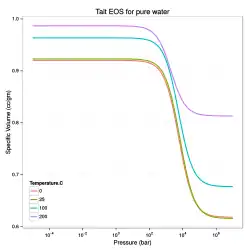Tait equation
In fluid mechanics, the Tait equation is an equation of state, used to relate liquid density to hydrostatic pressure. The equation was originally published by Peter Guthrie Tait in 1888 in the form[1]
where is the hydrostatic pressure in addition to the atmospheric one, is the volume at atmospheric pressure, is the volume under additional pressure , and are experimentally determined parameters. A very detailed historical study on the Tait equation with the physical interpretation of the two parameters and is given in reference.[2]
Tait-Tammann equation of state
In 1895,[3][4] the original isothermal Tait equation was replaced by Tammann with an equation of the form
where is the isothermal mixed bulk modulus. This above equation is popularly known as the Tait equation. The integrated form is commonly written
where
- is the specific volume of the substance (in units of ml/g or m3/kg)
- is the specific volume at
- (same units as ) and (same units as ) are functions of temperature
Pressure formula
The expression for the pressure in terms of the specific volume is
A highly detailed study on the Tait-Tammann equation of state with the physical interpretation of the two empirical parameters and is given in chapter 3 of reference.[5] Expressions as a function of temperature for the two empirical parameters and are given for water, seawater, helium-4, and helium-3 in the entire liquid phase up to the critical temperature . The special case of the supercooled phase of water is discussed in Appendix D of reference.[6]
Tait-Murnaghan equation of state

Another popular isothermal equation of state that goes by the name "Tait equation"[7][8] is the Murnaghan model[9] which is sometimes expressed as
where is the specific volume at pressure , is the specific volume at pressure , is the bulk modulus at , and is a material parameter.
Pressure formula
This equation, in pressure form, can be written as
where are mass densities at , respectively. For pure water, typical parameters are = 101,325 Pa, = 1000 kg/cu.m, = 2.15 GPa, and = 7.15.
Note that this form of the Tate equation of state is identical to that of the Murnaghan equation of state.
Bulk modulus formula
The tangent bulk modulus predicted by the MacDonald–Tait model is
Tumlirz–Tammann–Tait equation of state

A related equation of state that can be used to model liquids is the Tumlirz equation (sometimes called the Tammann equation and originally proposed by Tumlirz in 1909 and Tammann in 1911 for pure water).[4][10] This relation has the form
where is the specific volume, is the pressure, is the salinity, is the temperature, and is the specific volume when , and are parameters that can be fit to experimental data.
The Tumlirz–Tammann version of the Tait equation for fresh water, i.e., when , is
For pure water, the temperature-dependence of are:[10]
In the above fits, the temperature is in degrees Celsius, is in bars, is in cc/gm, and is in bars-cc/gm.
Pressure formula
The inverse Tumlirz–Tammann–Tait relation for the pressure as a function of specific volume is
Bulk modulus formula
The Tumlirz-Tammann-Tait formula for the instantaneous tangent bulk modulus of pure water is a quadratic function of (for an alternative see [4])
Modified Tait equation of state
Following in particular the study of underwater explosions and more precisely the shock waves emitted, J.G. Kirkwood proposed in 1965[11] a more appropriate form of equation of state to describe high pressures (>1 kbar) by expressing the isentropic compressibility coefficient as
where represents here the entropy. The two empirical paramaters and are now function of entropy such that
- is dimensionless
- has the same units as
The integration leads to the following expression for the volume along the isentropic
where .
Pressure formula
The expression for the pressure in terms of the specific volume along the isentropic is
A highly detailed study on the Modified Tait equation of state with the physical interpretation of the two empirical parameters and is given in chapter 4 of reference.[12] Expressions as a function of entropy for the two empirical parameters and are given for water, helium-3 and helium-4.
See also
References
- Tait, P. G. (1888). "Report on some of the physical properties of fresh water and of sea water". Physics and Chemistry of the Voyage of H.M.S. Challenger. Vol. II, part IV.
- Aitken, Frederic; Foulc, Jean-Numa (2019). From Deep Sea to Laboratory 3:From Tait's Work on the Compressibility of Seawater to Equations-of-State for Liquids. ISBN 9781786303769.
{{cite book}}:|website=ignored (help) - Tammann, G. (1895). "Über die Abhängigkeit der volumina von Lösungen vom druck". Zeitschrift für Physikalische Chemie. 17: 620-636.
- Hayward, A. T. J. (1967). Compressibility equations for liquids: a comparative study. British Journal of Applied Physics, 18(7), 965. http://mitran-lab.amath.unc.edu:8081/subversion/Lithotripsy/MultiphysicsFocusing/biblio/TaitEquationOfState/Hayward_CompressEqnsLiquidsComparative1967.pdf
- Aitken, Frederic; Foulc, Jean-Numa (2019). From Deep Sea to Laboratory 3:From Tait's Work on the Compressibility of Seawater to Equations-of-State for Liquids. ISBN 9781786303769.
{{cite book}}:|website=ignored (help) - Aitken, F.; Volino, F. (November 2021). "A new single equation of state to describe the dynamic viscosity and self-diffusion coefficient for all fluid phases of water from 200 to 1800 K based on a new original microscopic model". Physics of Fluids. 33 (11): 117112. arXiv:2108.10666. Bibcode:2021PhFl...33k7112A. doi:10.1063/5.0069488. S2CID 237278734.
- Thompson, P. A., & Beavers, G. S. (1972). Compressible-fluid dynamics. Journal of Applied Mechanics, 39, 366.
- Kedrinskiy, V. K. (2006). Hydrodynamics of Explosion: experiments and models. Springer Science & Business Media.
- Macdonald, J. R. (1966). Some simple isothermal equations of state. Reviews of Modern Physics, 38(4), 669.
- Fisher, F. H., and O. E. Dial Jr. Equation of state of pure water and sea water. No. MPL-U-99/67. SCRIPPS INSTITUTION OF OCEANOGRAPHY LA JOLLA CA MARINE PHYSICAL LAB, 1975. http://www.dtic.mil/dtic/tr/fulltext/u2/a017775.pdf
- Cole, R. H. (1965). Underwater Explosions. New York: Dover Publications.
- Aitken, Frederic; Foulc, Jean-Numa (2019). From Deep Sea to Laboratory 3:From Tait's Work on the Compressibility of Seawater to Equations-of-State for Liquids. ISBN 9781786303769.
{{cite book}}:|website=ignored (help)